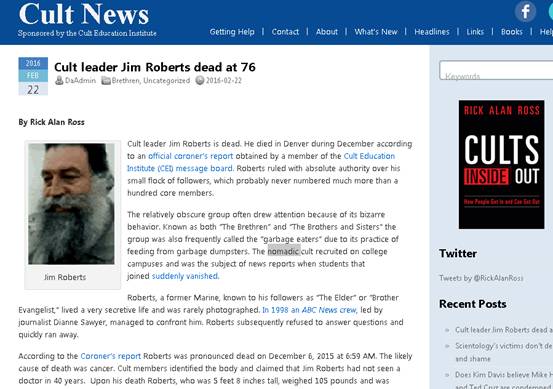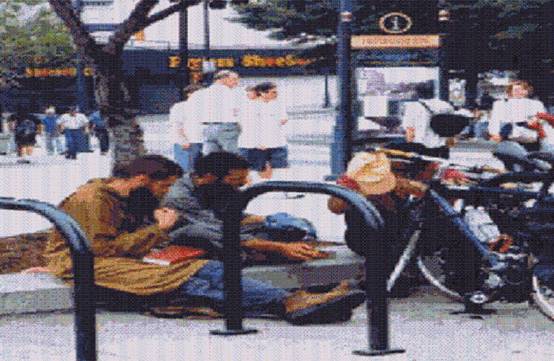Cult leader Jim Roberts is dead. He died in Denver during December according to an official coroner’s report obtained by a member of the Cult Education Institute (CEI) message board. Roberts ruled with absolute authority over his small flock of followers, which probably never numbered much more than a hundred core members.

The relatively obscure group often drew attention because of its bizarre behavior. Known as both “The Brethren” and “The Brothers and Sisters” the group was also frequently called the “garbage eaters” due to its practice of feeding from garbage dumpsters. The nomadic cult recruited on college campuses and was the subject of news reports when students that joined suddenly vanished.
Roberts, a former Marine, known to his followers as ”The Elder” or “Brother Evangelist,” lived a very secretive life and was rarely photographed. In 1998 an ABC News crew, led by journalist Dianne Sawyer, managed to confront him. Roberts subsequently refused to answer questions and quickly ran away.
According to the Coroner’s report Roberts was pronounced dead on December 6, 2015 at 6:59 AM. The likely cause of death was cancer. Cult members identified the body and claimed that Jim Roberts had not seen a doctor in 40 years. Upon his death Roberts, who was 5 feet 8 inches tall, weighed 105 pounds and was clothed in a green T-shirt, khaki trousers and an adult diaper. Authorities obtained fingerprints and digital photographs.
Followers in the Roberts group often “suffered health problems” that could have been cured through modern medicine. Instead at times they died due to medical neglect. One reportedly passed away from pneumonia.
The Roberts group claimed to be based upon the bible, but was known for encouraging its members to terminate contact with family with and old friends. Members then wandered from place to place under Roberts’s guidance fund raising and attempting to persuade people to join the group. Cult members lived largely from charity and whatever food they could find, much like homeless people. One former member explained that Roberts “weaseled his way into control until next thing you knew he was running every aspect of your life.” Another former member described Roberts as a “paranoid megalomaniac.”
CEI has maintained a subsection about the Brethren led by Jim Roberts since the 1990s. Many complaints over the years came from families desperately trying to locate lost loved ones submerged in the group that remained isolated and dominated by Roberts. Hopefully, now that Jim Roberts is dead some of those families will find their lost loved ones through restored communication. However, it is likely that long-time Roberts loyalists, influenced by the cult leader’s teachings, will try to maintain the group mindset and to some extent its historic pattern of behavior.
About The Cult

Origins
Jimmie T. Roberts (also known as Brother Evangelist Roberts), son of a former Pentecostal minister, created the movement around 1971, drawing together followers of the Jesus Movement across the United States. Roberts had become convinced that mainstream churches were too worldly, and wished to create a wandering discipleship patterned on the New Testament apostles. He began recruiting a core of followers in Colorado and California.At first they adopted a communal lifestyle.
Group Name
This Christian faith group actually has no formal name. Members refer it as a church, spiritual community, or assembly. It has been called The Brotherhood, Brothers and Sisters, The Roberts Group, and The Brethren. Counter cult groups, disaffected parents of Brethren, and others frequently call them by the derogatory term Garbage Eaters. This name apparently is derived from their practice of searching through supermarket dumpsters for over-ripe produce and food that is beyond their recommended expiry date.
The group is a cult, both sociologically and theologically. Theologically, the Roberts Group is a cult of Christianity - by virtue of the fact that its teachings and practices run counter to those of orthodox Christianity.
They have no connection to the much larger group, The Church of the Brethren, which first appeared in the U.S. in 1723 CE, and traces its roots back to the Anabaptist faith group in Europe.
Beliefs
Beliefs are prominently millenarian and apocalyptic, centered on the teaching that humanity is in the end times and that members must purify themselves in preparation for the end of the world. The movement directs new members to sell their possessions and break with their families as a necessary part of earning salvation.Any finances generated are distributed according to need. For instance, money might be used for material to sew clothing, traveling expenses, or cooking spices. In some cases new members' money was given to older members, but in other cases it was kept by the individual to do what they would with it.





